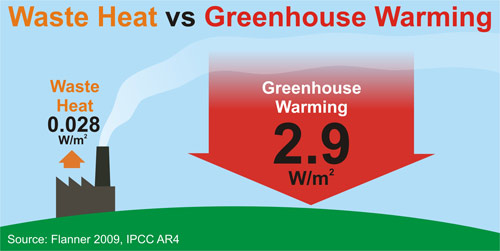Greenhouse warming 100 times greater than waste heat
What the science says...
| Select a level... |
 Basic
Basic
|
 Intermediate
Intermediate
| |||
|
The contribution of waste heat to the global climate is 0.028 W/m2. In contrast, the contribution from human greenhouse gases is 2.9 W/m2. Greenhouse warming is adding about 100 times more heat to our climate than waste heat. |
|||||
Climate Myth...
It's waste heat
"Global warming is mostly due to heat production by human industry since the 1800s, from nuclear power and fossil fuels, better termed hydrocarbons, – coal, oil, natural gas. Greenhouse gases such as carbon dioxide (CO2 play a minor role even though they are widely claimed the cause." (Morton Skorodin)
When humans use energy, it gives off heat. Whenever we burn fossil fuels, heat is emitted. This heat doesn't just disappear - it dissipates into our environment. How much does waste heat contribute to global warming? This has been calculated in Flanner 2009 (if you want to read the full paper, access details are posted here). Flanner contributes that the contribution of waste heat to the global climate is 0.028 W/m2. In contrast, the contribution from human greenhouse gases is 2.9 W/m2 (IPCC AR4 Section 2.1). Waste heat is about 1% of greenhouse warming.

What does these numbers mean? They refer to radiative forcing, the change in energy flux at the top of the atmosphere. Or putting it in plain English, the amount of heat being added to our climate. Greenhouse warming is currently adding about 100 times more heat to our climate than waste heat.
Last updated on 27 July 2010 by John Cook. View Archives































 Arguments
Arguments
































Somebody's crunched numbers. Small globally, noticeable regionally: Nearly all energy used for human purposes is dissipated as heat within Earth's land–atmosphere system. Thermal energy released from non-renewable sources is therefore a climate forcing term. Averaged globally, this forcing is only +0.028 W m−2, but over the continental United States and western Europe, it is +0.39 and +0.68 W m−2, respectively. Here, present and future global inventories of anthropogenic heat flux (AHF) are developed, and parameterizations derived for seasonal and diurnal flux cycles. Equilibrium climate experiments show statistically-significant continental-scale surface warming (0.4–0.9°C) produced by one 2100 AHF scenario, but not by current or 2040 estimates. However, significant increases in annual-mean temperature and planetary boundary layer (PBL) height occur over gridcells where present-day AHF exceeds 3.0 W m−2. PBL expansion leads to a slight, but significant increase in atmospheric residence time of aerosols emitted from large-AHF regions. Hence, AHF may influence regional climate projections and contemporary chemistry-climate studies. Flanner, M. G. (2009), Integrating anthropogenic heat flux with global climate models, Geophys. Res. Lett., 36, L02801, doi:10.1029/2008GL036465.